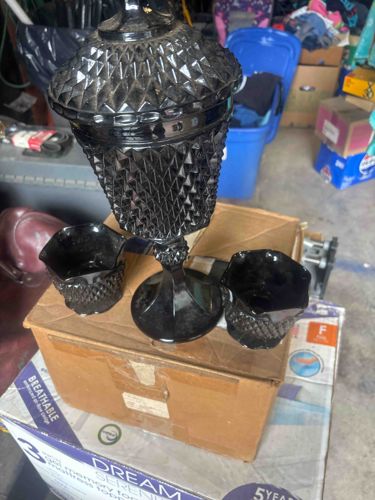
Black Diamond-Point Pressed Glass Compote Set
The item is a three-piece set of what appears to be black pressed glass, likely a covered compote or candy dish with two accompanying smaller footed dishes, possibly open salts or nut dishes. The primary piece, the compote, features a prominent diamond-point or hobnail pattern covering the entire body of the bowl and its domed lid. The pattern is deeply molded, creating a tactile and visually textured surface. A band of smooth glass separates the top and bottom sections of the main bowl. The top of the lid is adorned with a finial, also likely molded glass, though its specific design is not clearly visible. The compote stands on a pedestal base, which appears to have a more fluid, possibly even fluted or paneled design before tapering to a circular foot. The two smaller accompanying pieces echo the main compote's design, each featuring the same diamond-point or hobnail pattern around their lower bodies and standing on their own smaller pedestal feet. All pieces are a consistent opaque black, characteristic of 'black glass' or 'Amethyst Slag' glass, which appears black in most lighting but can show deep purple hues when strong light is passed through it, though this is not discernible from the image. The manufacturing method suggests pressed glass, a common technique for mass production of decorative glassware from the late 19th to mid-20th century. A significant condition issue noted is a crack down the bowl of the main compote. This suggests potential fragility or previous impact damage. Other condition indicators such as chips, scuffs, or significant wear are not readily visible but should be thoroughly inspected. The presence of a crack significantly impacts the structural integrity and value of the piece. Without maker's marks, it is difficult to attribute to a specific manufacturer, but the diamond-point pattern was popular across various glass manufacturers during the Victorian and Depression eras. The overall quality of the molding, particularly the sharpness of the diamond points, would indicate the level of craftsmanship. The set likely dates from the late 19th to early 20th century, consistent with the style of black opaque glass and pressed glass patterns of that period.
AI-Generated Appraisal Disclaimer
Estimated Value
$40-60
Basic Information
Category
Decorative Glassware
Appraised On
December 7, 2025
Estimated Value
$40-60
Additional Details Provided By Owner
User Provided Information
It has a crack down the bowl of it
Item Description
The item is a three-piece set of what appears to be black pressed glass, likely a covered compote or candy dish with two accompanying smaller footed dishes, possibly open salts or nut dishes. The primary piece, the compote, features a prominent diamond-point or hobnail pattern covering the entire body of the bowl and its domed lid. The pattern is deeply molded, creating a tactile and visually textured surface. A band of smooth glass separates the top and bottom sections of the main bowl. The top of the lid is adorned with a finial, also likely molded glass, though its specific design is not clearly visible. The compote stands on a pedestal base, which appears to have a more fluid, possibly even fluted or paneled design before tapering to a circular foot. The two smaller accompanying pieces echo the main compote's design, each featuring the same diamond-point or hobnail pattern around their lower bodies and standing on their own smaller pedestal feet. All pieces are a consistent opaque black, characteristic of 'black glass' or 'Amethyst Slag' glass, which appears black in most lighting but can show deep purple hues when strong light is passed through it, though this is not discernible from the image. The manufacturing method suggests pressed glass, a common technique for mass production of decorative glassware from the late 19th to mid-20th century. A significant condition issue noted is a crack down the bowl of the main compote. This suggests potential fragility or previous impact damage. Other condition indicators such as chips, scuffs, or significant wear are not readily visible but should be thoroughly inspected. The presence of a crack significantly impacts the structural integrity and value of the piece. Without maker's marks, it is difficult to attribute to a specific manufacturer, but the diamond-point pattern was popular across various glass manufacturers during the Victorian and Depression eras. The overall quality of the molding, particularly the sharpness of the diamond points, would indicate the level of craftsmanship. The set likely dates from the late 19th to early 20th century, consistent with the style of black opaque glass and pressed glass patterns of that period.
Get Your Items Appraised
Instant estimates of your treasures with AI-powered instant appraisals